The trailblazing story of producer and owner Efrain Nolasco
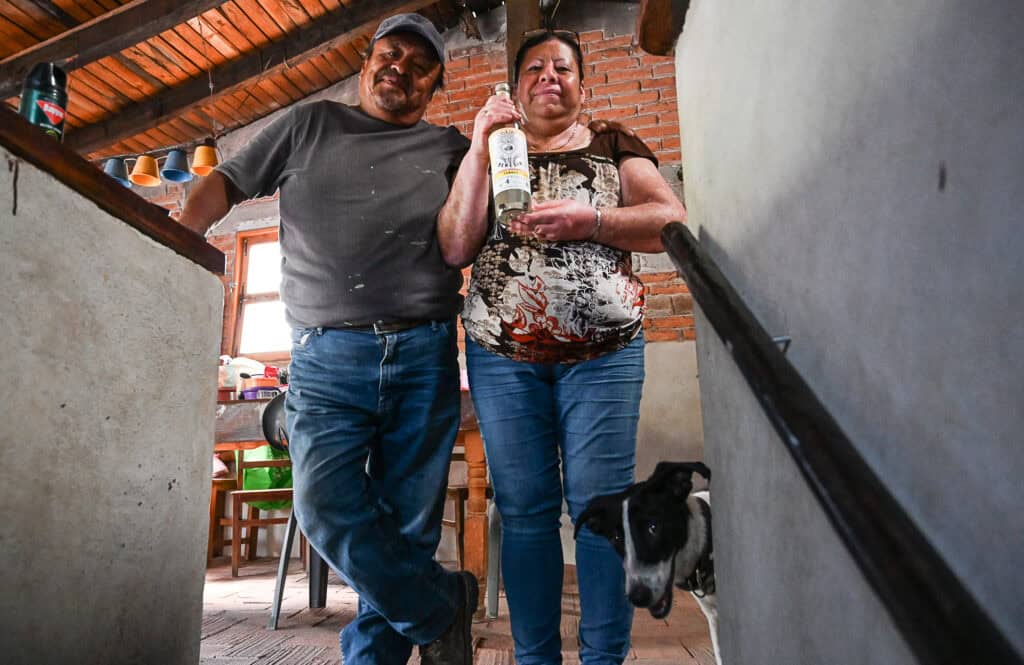
Benesin is a small-batch mezcal produced in San Juan del Rio, a small town in the mountains of Oaxaca. The brand was formed by Master mezcalero Efrain Nolasco and launched in 2006, making it one of the earliest producer owned, artisanal mezcals to make it to the US market.
The name Benesin comes from Zapotec, the principal language of San Juan del Rio. It means “knowledge of the people. Ben for people, messin is knowledge.”
The bottle has a clean, white cotton paper label depicting two hands cupping a heart with an eye inside. Typically this combination represents love, luck, and protection. Above the heart is an agave, which looks like the traditional flaming heart of Mexican folklore, where the heart symbolizes hope. This representation of learning, love and hope is evocative of Nolasco’s journey to revitalize mezcal production in his community.
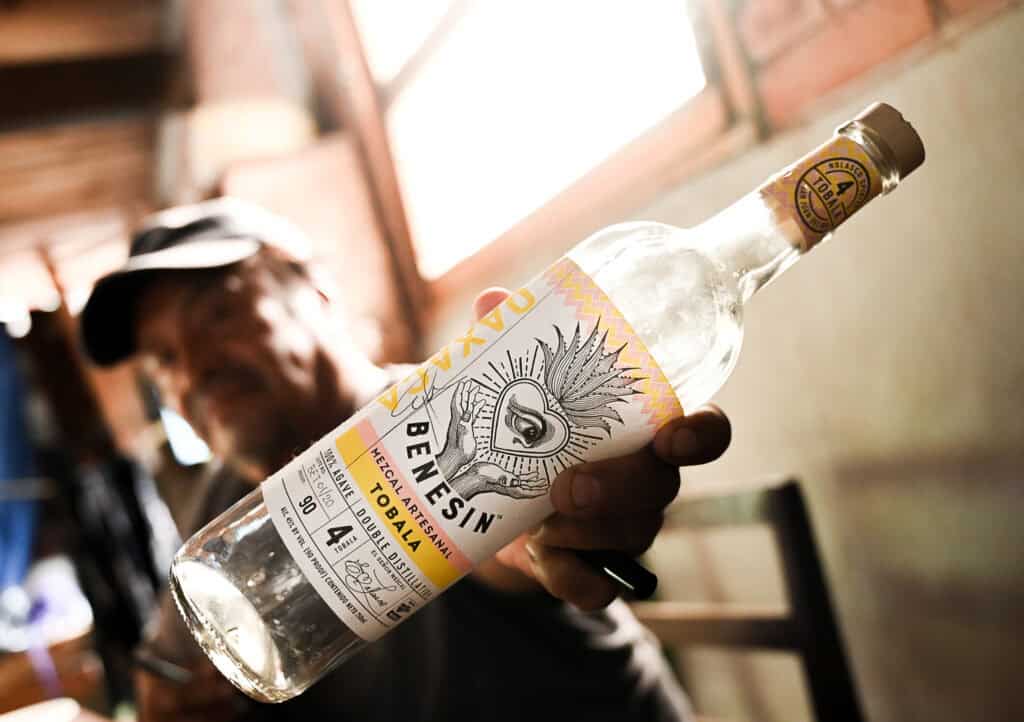
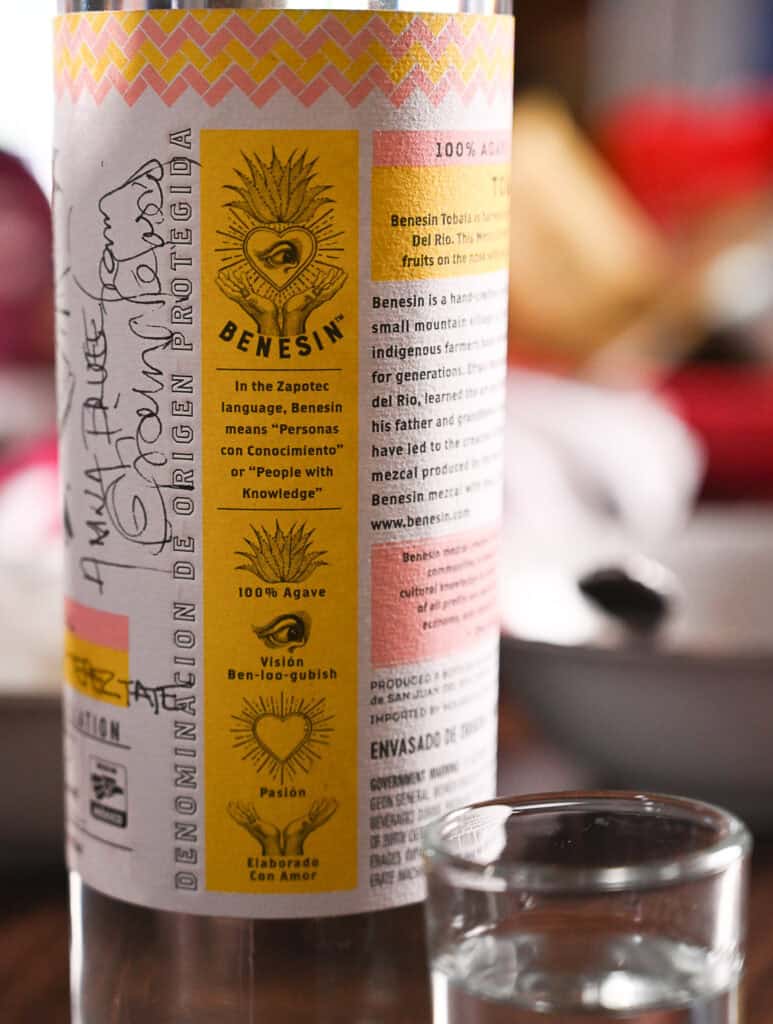
The art and tradition of mezcal production was something Nolasco learned from his father and grandfather. He remembers “As a kid, I would go out to help harvest the agave and push the horse.” There weren’t roads so they walked or used donkeys for transport, including harvesting agave. “We collected 1000 kg of agave, I think in a week.That was my childhood.”
Nolasco remembers that his parents were not well off in the town. “They only had three years of schooling. There were no roads, there was no light, there was no drainage, there was nothing.” However, they did see his potential, sending him for some further education, until he was 14. “My dad sent me there because I had a bit more talent, a bit, I don’t know if I had brains or what.”
Nolasco was curious about the wider world, which led him to move away from his town. First to Mexico City, then in 1987 he emigrated to the United States in pursuit of the American dream. There he lived in Santa Rosa, California, working in landscaping and construction.
During the 1990s there was boom and bust in the agave market led by the Tequila industry buying up Oaxacan agave. Nolasco explains that “first the state of Jalisco came and bought all the agave, and the mezcal production collapsed. Then Jalisco started growing their own and stopped buying the agave.”
This meant agave being grown for buyers in Jalisco (Tequila) was no longer bought. The shift was devastating for the community of San Juan del Rio, where approximately 80% of the population had been involved in agave farming.
Nolasco wanted to bring back his community’s mezcal producing legacy. In 2000 he returned home to pursue this dream. He spent the next five years learning about all the regulations surrounding mezcal production. He combined this with his knowledge of the California system of regulation.
He feels that to get mezcal “on to the best tables of the best men, you have to get organic certification.” “I contacted CCOF California Certified Organic Farmers and they came here to tour the fields. We were like 15 or 20 producers from here.”
In 2006, Nolasco launched his mezcal and became the first producer to become certified organic. “The pureness is important,” he said. He still gets the production certified organic, personally paying the fee and travel costs for the officials to check his land and palenque.
Now he is passionate about continuing this tradition for his family and community. “In my hometown, we use it for everything. When we have a party, we have to toast with mezcal first, and we pour a few drops on the ground … the earth gave it to us, so we have to give back to it.”
In 2010 Nolasco’s mezcals were singled out for best value by a writer for the New York Times, while in 2013, the product review site, TheFiftyBest.com, awarded the Benesin Añejo a Double Gold medal and gold for the Espadin agave expression. Following these accolades, Nolasco became known in the industry as “Señor Mezcal.”
My introduction to Nolasco was through Susan Coss (of Mezcalistas) who had recently caught up with him and his daughter Jennifer in California. She remembers meeting him for the first time around the launch of Mezcalistas in 2012. “What I clearly remember was his pride, introducing me to his mezcal Benesin. Because he was not only the owner but also the producer of the mezcal, he was able to give a perspective that was so crucial in those early days (of Mezcalistas).”
Nolasco also recalls Susan fondly, describing her as an “encyclopedia” of knowledge about mezcal.
Last month, in August, I finally made my first trip to see Nolasco at the Benesin palenque. It took a while for us to coordinate the visit, as he was getting home from his trip to the states, arriving back in Oaxaca’s rainy season. Although we are all elated about finally getting rain, it does make some of the routes a little more challenging!
Once we had figured out a date, I tried to get a map pin for the Nolasco’s palenque in the picturesque village of San Juan del Rio. The community, of approximately 1300 people, is nestled in a steep river valley. Houses are built into the hillside, interspersed with areas of agave and corn. Most of the distilleries are down near the river itself with the stills at the river level, as the mezcaleros use the water for cooling the stills. This is a similar setup to San Luis de Rio.
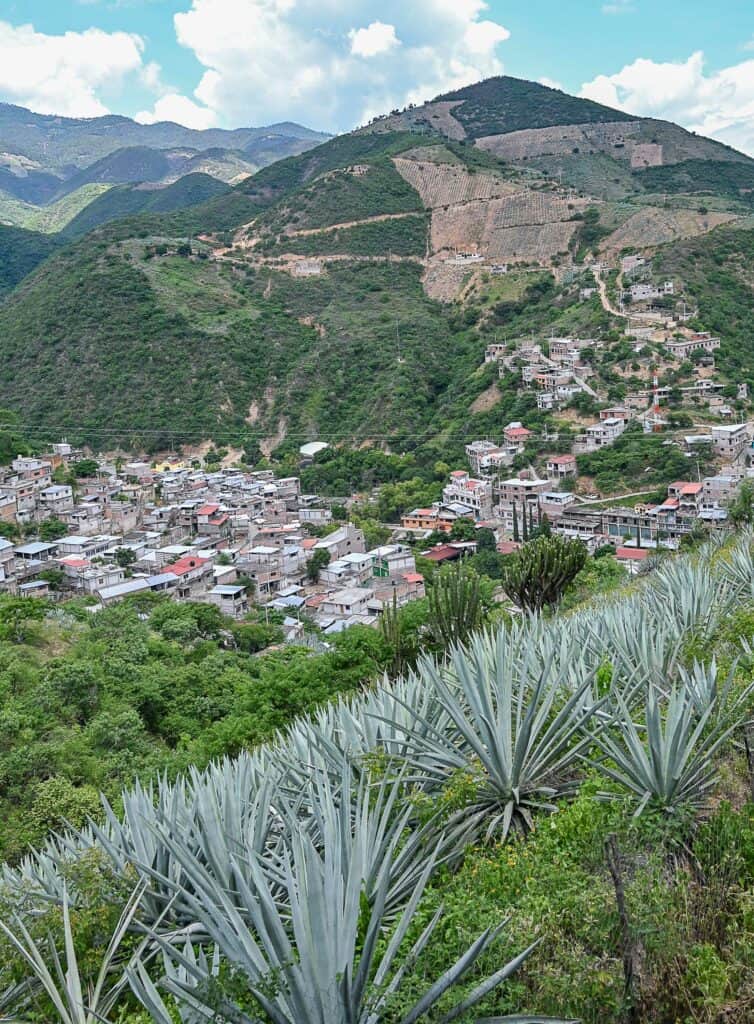
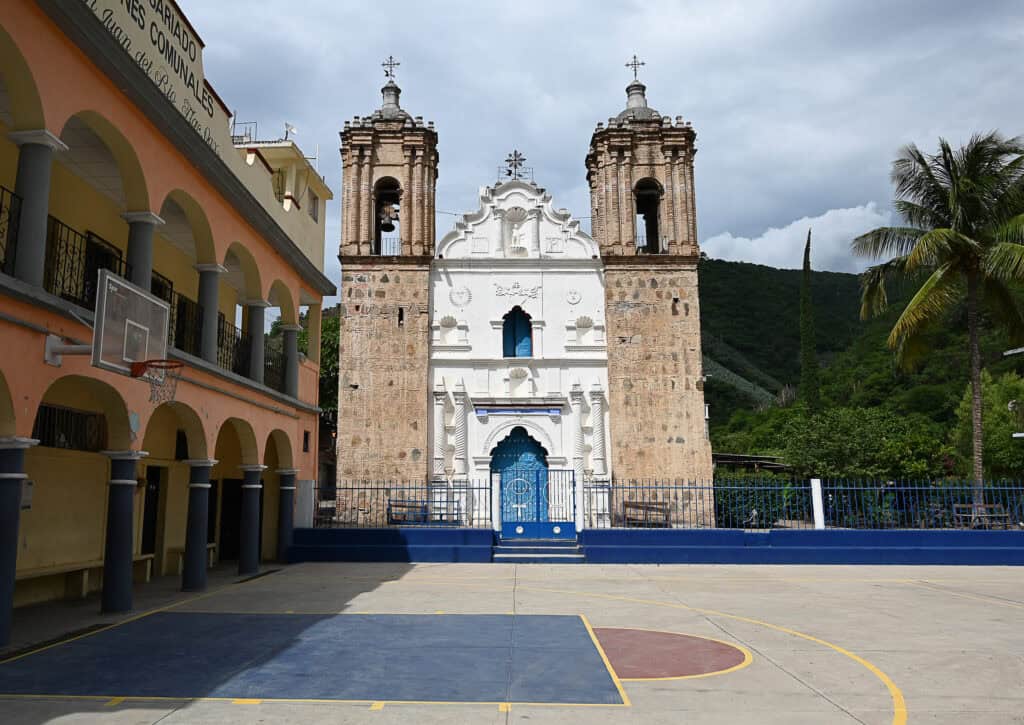
Rather than a map pin, Nolasco gave me a description of where to find him once in the town – two hundred meters past the welcome arch, near the secondary school where I was supposed to “ask for Efrain”. These instructions were followed up by a comment that I should NOT follow google maps to San Juan, but to enter via another town off the highway. Typically I missed this and ended up crossing rivers, driving down dirt tracks, through agave fields, with no phone service to let Nolasco know we would be a good hour late.
I needn’t have worried. In true mezcal adventure style, we made it to the meeting point – a little muddy and wiser about listening to directions – but otherwise fine. Nolasco was chilling at his truck, with a smile on his face. Of course he welcomed his slightly frazzled guests to a mezcal the moment we got to his palenque.
The palenque is set into a very steep mountain side, so the view over San Juan is breathtaking. But it is also a tough spot, exposed to the elements. While we sat and sipped, workers were fixing the roof, which had blown off just days before. “It rained really hard and all this blew away because of the storm. I was in California. It always happens when you’re not there!”
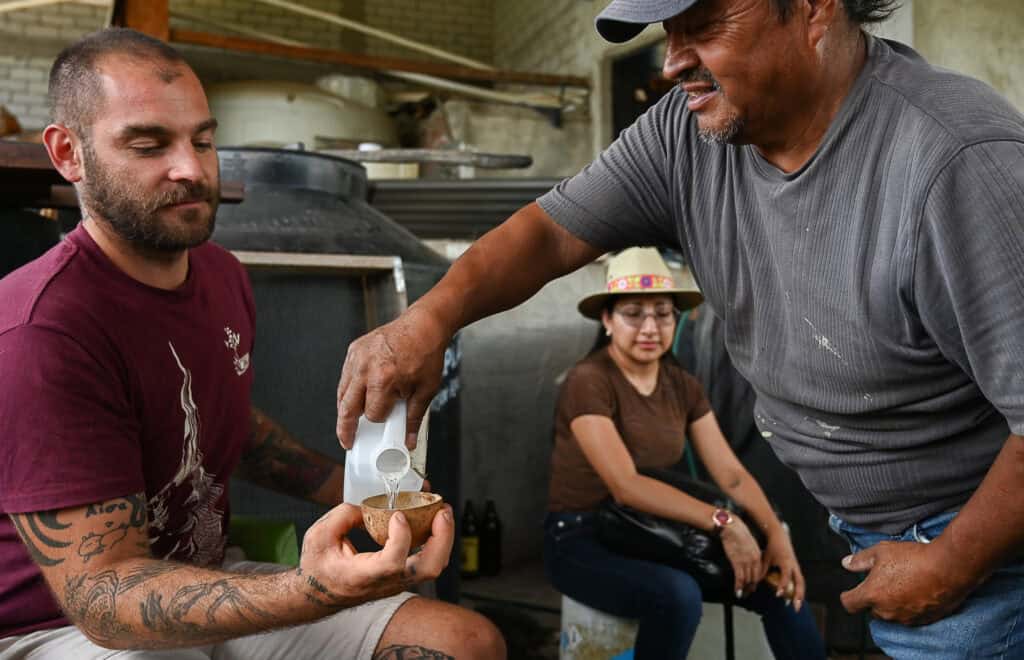
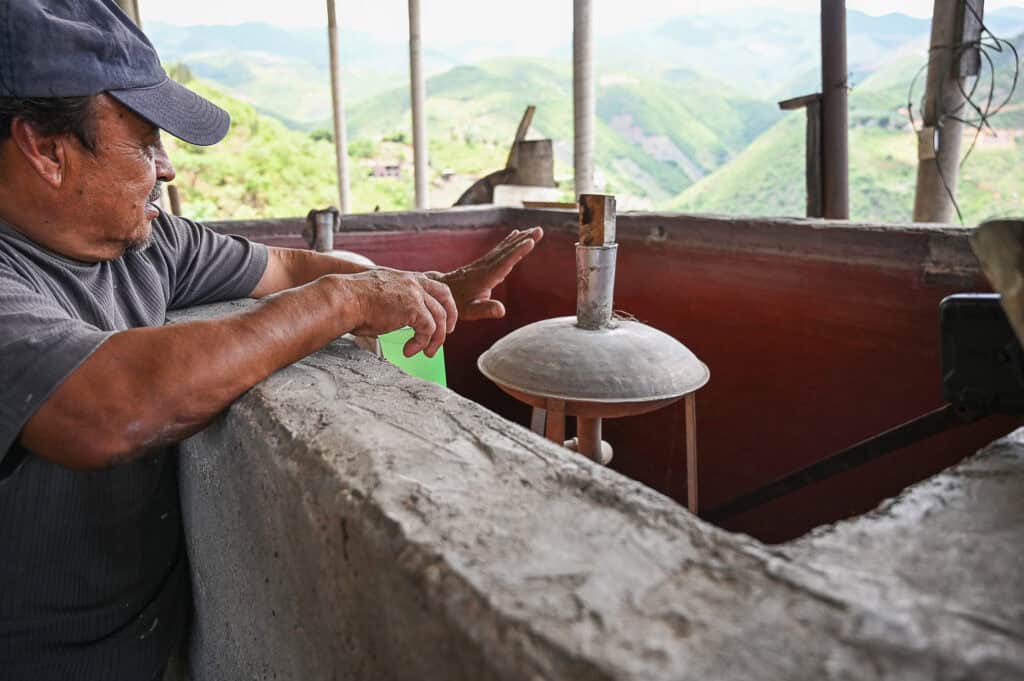
We sat between the fermentation vats. Along the hillside from us were two stills, and construction for two more. Up the slope from us was the mezcal store where Nolasco does some aging as well.
Slightly below us was a room that enclosed the space, but was also separate from the rest of the palenque activity. This was for a large water storage tank. Nolasco explained that he captures rainwater from the roof. This is the only water he uses for fermentation. The water to cool the distillation is brought by truck from the river in the valley below.
When he returned to Oaxaca in 2000 he only had this site to work with. He said people didn’t expect him to succeed, particularly because of the distance from the river. Fortunately he has found a solution, in the rain capture system. Rain capture is something that can be seen in other palenques, such as the beautiful new space designed for Los Ocotales.
As with much of Mexico, finding ways to conserve water is essential in San Juan del Rio.
Nolasco’s process involves harvesting the agave once fully mature, using mules to get them off the steep mountainside. They bake the agave in a rock-lined pit oven for 48 hours. For him this is the sweet spot for a “good roast”, to bring out the natural agave sugars and “ the exact flavor of smokiness.”
The cooked agave is then crushed by a mule-pulled, stone tahona. This creates a pulp of agave fiber and juice.Along with the collected rainwater, this pulp is fermented for approximately 8-10 days in the wood vats that we were using as wind shelters during our visit.
Once the tepache is ready it is put into the still. The first pot is copper, for heat distribution, but the second is stainless steel. Nolasco, who studied agronomy, explains that it is healthier and cleaner to have distillation coming through steel.
The ordinario, or shishe, is batched from the first distillation, then it is run through the still again. At this point the cuts of heads, bodies and tails are made. Nolasco does not discard the tails, but adds them back to the shishe in the next run. The Benesin range is finished at 45% alcohol.
When the mezcal is finished a shipping company delivers the cases to Tijuana, where it goes through customs, then he sends a truck to pick it up and take it on into California. This is managed through his own import company Nolasco Spirits, which he has developed to bring small batch and family owned mezcals to the market. So far, as well as Benesin, these include Tr3s Tiempos and Amateco.
Currently his niece, Luz,runs the administrative part of the business, helping him with paperwork, such as registering for certification and export. His children are in California. He is keen to keep developing Benesin for their futures, as well as continuing to use his platform to support his community of San Juan del Rio.
Nolasco shared with us his espadin, an ensamble of tobala/tepeztate and a pechuga, serving the mezcal in bowl sized jicaras. The espadin and ensemble were delicious, but the pechuga was particularly unusual, distilled with herbs picked from around the distillery, including copal. Copal is the wood used for alebrijes, which has a scented resin that can be burnt to make a scented smoke.
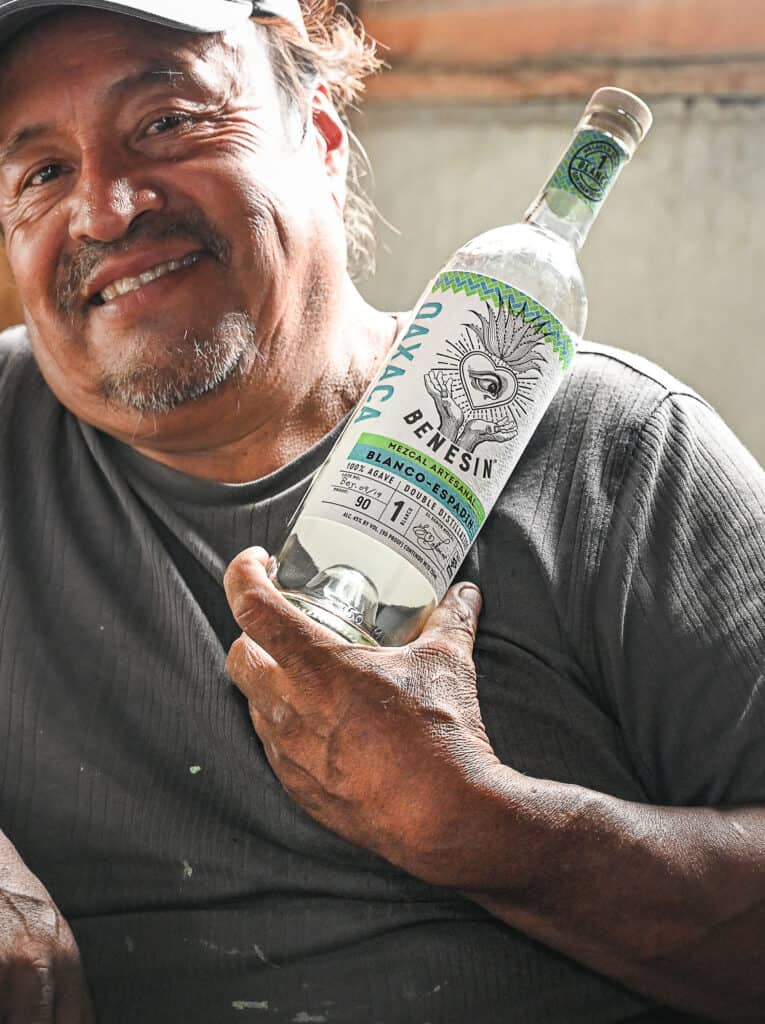
Nolasco describes making mezcal as “una obra culinaria,” a culinary work. The complexity of his flavors and the uncompromising passion behind Nolasco’s mezcal is testament to this belief.
At the end of our visit we wanted to buy some bottles to take home. Generously Nolasco tried to give us the bottles, and when pressed (we wanted to buy more), he said just to pay him what we felt was right. “My mezcal is affordable”. He explains “I want to educate people, and let them know what good mezcal is.”


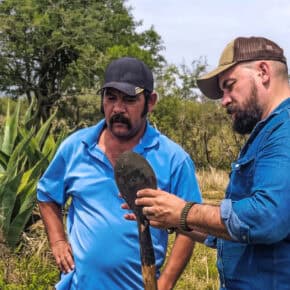
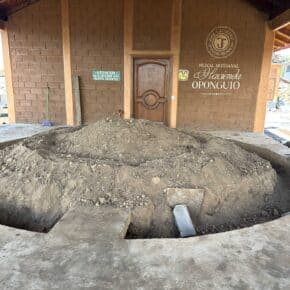








Leave a Comment